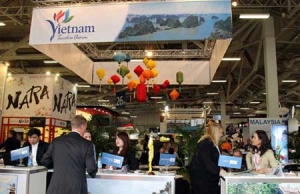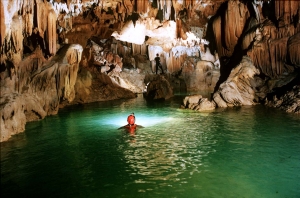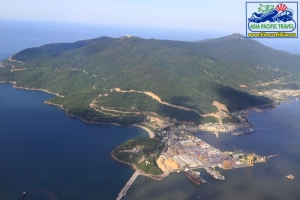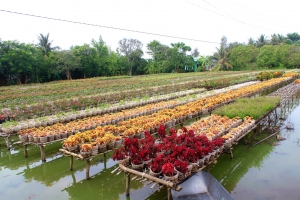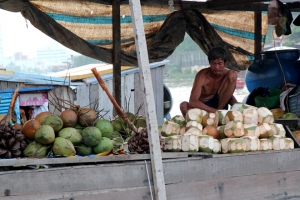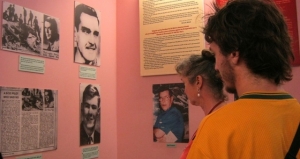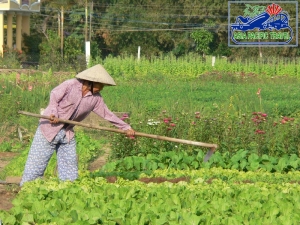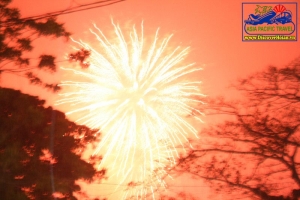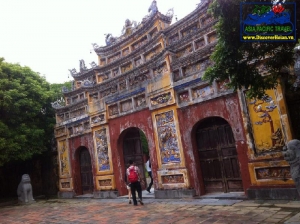
Asia Pacific Travel Team
Vietnam attends Iranian tourism fair for first time
The Vietnamese pavilion attracted a large crowd of Iranian friends to examine the tourism opportunities in Vietnam during the first day of the fair, which is the eighth of its kind.
The visitors were particularly impressed by the Vietnamese “non la” (conical hat), “ao dai” (long dress), and local cuisine.
Several businesses in the host country also took the occasion to work with the Vietnamese Embassy in Iran, and Eviva and South Pacific tour operators to launch tour packages for Iranian nationals to visit Vietnam. They also expressed their intent to further explore bilateral cooperation in the field.
The fair offers a brilliant opportunity for Vietnamese firms to promote the country’s tourism sector to international friends from Armenia, India, the Republic of Korea, Malaysia, Turkey, China, Tunisia, and Switzerland.
It will run until February 15.
Deep within Phong Nha cavern
THE BEAUTY OF PHONG NHA CAVES CAN ONLY BE REACHED BY AN EXACTING TREK OVER MOUNTAINS AND DOWN THROUGH VALLEYS, BUT THE REWARDS ARE WELL WORTH THE EFFORT
My trip to Phong Nha in central Quang Binh province took place about a year after I moved to Hanoi. I was living with four housemates, one of whom worked in the tourism industry and was heading down to Phong Nha to help set up a caving tour. There were two trails in the jungle, she explained, one starting in the west and the other in the east, but they didn’t meet up in the middle. It was her job to connect the two to creat a continuous trail that went through one of the cave systems. As she told us all about it she could see the excitement in our eyes, so she invited us along for the journey…to which we all said “YES!”

The journey began with a train trip from Hanoi to a village just a little north of Hue, where we got off and were taken to the office of the travel company, which was about 20 kilometres away in another village. When we arrived there was no time for sitting around; all of the gear we would need for the trek was laid out ready for us to pack into our own bags. Unfortunately, that meant we had to ditch most of the comfort items we brought with us for four-day trek, like a change of clothes. After about an hour packing, unpacking and repacking, we set off down the road to catch a boat that would take us about four hours up a river.

The boat ride came to an abrupt end as we reached a dam. From there, we had a very long trek ahead of us to reach the caves. It was hot, I was hungry, and my bag was pretty heavy. But I knew from previous hikes that the first couple of hours are always the worst. We came to a point where we needed to cross a river and there were some people who were willing to take us across on some rather sketchy boats. We made it across and then walked up the embankment onto a road. By this time everyone had enough of walking for the day so we sat on the side of the road and were deciding what to do when one of those crazy country buses came screeching to a halt to see if we wanted a ride.
We all locked at each other and didn’t even need to say a word. We jumped on the bus and cranked up the AC. Most of our fellow travelers had never seen a westerner before, so they were full of questions as we sat squashed together in the compact bus. We had a lot of laughs and made a few friends, but unfortunately we had to leave them and the AC to get back to the trail.

Once back on the trail we were all recharged and ready to go. We put one foot in front of the other and marched on and on up hills, down hills, through streams and across valleys until we reached a stream that came out from the side of a mountain through a small cave opening. The only way across was to carefully grip the side of the cave walls and very slowly work your way across over the opening. This was the first true test of the trek. The sharp, slippery rocks and the uncomfortable climbing angle made it that much more of a challenge not to slip and fall into a pool filled with more sharp and slippery rocks. One by one, we all made it across to a beach, which would be our first camping site of the trip. The first day had been long and tiring, so after a few shots of rice wine and a delicious meal made over the fire we all retired to the hammocks we had tied to trees.
At the crack of dawn I was awake. We had a quick breakfast and started walking to a large cave nearby. What I saw when I reached the massive opening was better than anything I could have imagined. I looked like a scene out of The Lost World. Lush green plants grew everywhere. We all took time to take in the sight before the guides handed us some flashlights and we entered the cave. Not long in we had to cross a very narrow “bridge” in order to reach the back caverns. The bridge seemed to be part of an old pool that had dried up a long, long time ago. It was narrow, slippery and looked like it was made of millions of drip of wax from candle. The tour guides made it easily across, walking very slowly one foot at a time as if they were on a tightrope. When it was my turn to cross. I started out walking just as they were, but then I looked down. All I saw was black. I shined my flashlight to the right and it was as if I had shined into a black hole; the light just disappeared into the darkness. At that point I decided to sit down and slowly edge my way cross.

As we went deeper and deeper into the cave we reached the middle of large cavern that was difficult to manoeuvre around due to random holes in the cave floor that plunged unknown depths. I managed to get close enough to one of the cave walls and shone my light on what looked like a group of reflections. To my dismay I discovered that the reflections were actually massive spiders. I panned the wall with my light only and saw there were hundreds and hundreds of these things all over the place. That was when we decided to leave.
We had a long trek over a couple of mountains that needed to be done over the next day and a half to get to another cave system. We hiked until we could not hike anymore; the mountains and the heat were taking their toll. We were slowly accepting the fact that we still had a few hours to hike that day when we stumbled upon a logging road just as two trucks passed by. Thinking fast, we flagged them down and the drivers agreed to let us hop in the back, dropping us off close to a small village by a river where we camped for the night.
The next day it was another early rise as we headed for the new cave system. After reaching the mouth we crawled through an unassuming hole at the base of the mountain down to an underground river that would lead us to the other side. As we were putting on our life jackets in order to safely float down the current, we were told to float with our feet first so we didn’t get stabbed by submerged stalamites. After a few minutes in the water there was a visible light at the end of the river and at that point we were swept out of the cave and into the pool, the guides told us, was because “we don’t know where it goes”
After overnight stay in the mouth of the cave where the river exited, we were on our way back home. We spent the whole day trekking back to a village before getting into a waiting bus. We said our goodbyes to the friends that we had made on our adventure and we headed to the train station for the trip back to Hanoi. It was a tough trip, but I’d do it again in a heartbeat.
The Guide
Ma Pi Leng Pass - A legend carved
THE STORY BEHIND “THE ROAD OF HAPPINESS” WHICH ZIGZAGS THROUGH THE HIGH MOUNTAINS OF THE NORTHERN PROVINCE OF HA GIANG, IS AN EPIC TALE OF SACRIFICE AND HUMAN SPIRIT

One of the most popular destinations for travelers over recent years has been Ha Giang, for its magnificent beauty of terraced fields, forests, mountains, and Dong Van’s stunning karst plateau, with its highest peak, Ma Pi Leng, standing at 1200 metres above sea level.
Standing on Ma Pi Leng peak, it’s as through you could reach up and touch the white clouds. From here an exotic panorama presents itself before your eyes, with imposing rocky mountains and deep valleys cut by the charming Nho Que River. Like a silk scarf, Con Duong Hanh Phuc ( The Road Of Happiness) winds its way around mountains and is regarded as the Silk Road of the region, because without it the area would be all but closed off.
PEOPLE POWER

Dong Van karst plateau was a hidden, unknown gem before the road was built. Giant rocky mountain ranges blocked entry to outsiders and kept local people largely hemmed in. More than 80,000 ethnic minority people in the highlands never knew a real road. For generations they climbed oer mountain paths, on foot and sometimes on horseback. A trip to nearest town could take a month. Life was difficult, short of food and clean water and separated from the modern world.
After relative peace came to north, in 1959 the government decided to build a 200-kilometre road to connect the centre of Ha Giang and Dong Van plateau, including the four districts of Quan Ba, Yen Minh, Dong Van and Meo Vac, helping the area eliminate its dire poverty.

It was no easy task. In its 80 years of dominion over Vietnam the French had tried to construct a similar road but only managed 17 kilometres. Lacking modern machinery and equipment, the Vietnamese people nonetheless believed they could succeed whre the French had failed. But Ha Giang need help from elsewhere. Responding to the call, tens of thousands of young people, including volunteers from 16 ethnic minority groups in eight northern provinces, gathered together to break through the rocky ranges and pave a new way and a new life for their poor brothers and sisters.
With basic tools like hammers, crowbars, hoes, and shovels, and some explosives, the people carved out the road centimeter by centimeter until it stretched 200 kilometres in length at a width of 4.5 metres.
To encourage a working spirit, the youngsters started a compettion, as one of them, Nguyen Manh Thuy, told to local media. Whoever could bore into the mountain at the largest depth was the champion of the day. The best effort was a 4.7-metre dig in just eight hours.
The geography of mountains, valleys and streams often meant a hundred metres of road took several months to build. But the greatest difficulty came after 1,000 days of construction, when they faced Ma Pi Leng. In the local H’mong language, Ma Pi Leng means “the bridge of a horse’s nose”, implying the shape of the peak and perhaps the fact that horses found breathing difficult when ridden to the peak in days gone by. Continuing the road required carving out a mountain pass, but how could this be done with just basic tools ? It was here that the real legend of The Road of Happiness came to be.
ELEVEN MONTHS AT 1,200 METRES

A “suicide” squad of 17 of the most courageous members of the crew was assembled. They climbed the cliffs of Ma Pi Leng and ties themselves by rope to a big old tree. The they hung on a cliff some 56 metres from the peak, as they worked on the pass. Together with tents went coffins, as many made the ultimate sacrifice.” Every morning we held a commemoration to ourselves to the rope and descending from the peak, “Nguyen Viet Cho, a member of the squad, told to local media.
Hanging on the cliff face in the middle of clouds and wind, these brave souls bored small holes into the cliff with crowbars and hammers and placed explosives inside. As each explosion broke a block of rock the size of a football, their happiness also broke out, said Cho.
The squad then received a drill to quicken the pace and finish their work on the cliff face. Eleven months had yielded a 22-kilometre mountain pass, connecting Dong Van and Meo Vac. With nine sections zigzagging around vertical cliffs and deep into the valley. Ma Pi Leng Pass, regarded as “Vietnam’s Great Wall” became one of the most perilous passes in the north and, later, an alluring challenge for adventure travelers.
SACRIFICE FOR HAPPINESS

During the long battle to overcome the rocky “enemy” and complete the road, the brave souls had to also fight other battles.
After completing the first nine kilometers of the road they were harassed constantly by bandits from region’s drug industry, according to Thuy. Only after the bandit leaders were captured could they continue the task. A vigilant team was assigned to guard the workers every day.
For thousand of days, with post-war hardships very much the reality, their meals consisted of only rice, vegetables and salt, and their accommodation were shacks. But the lack of water was the greatest difficulty. Thuy recalled. “In the middle of the rocky highlands, water was gold” he said “We were given a bucket of water a day. Thus, with each mug of water, to save the golden resource, we creatively “recycle” it, when brushing our teeth, washing our faces, and washing our gloves or sharpening our tools”. Bathing was luxury they could scarcely afford, even thought their bodies were caked with dust. “Having a bath required a day off” Thuy smile. “We had to walk for the whole afternoon to return. When we got back we were then “bathed” in sweat.”
Besides the harsh living conditions they also faced mosquitoes and malaria, not to mention the ever-present threat of death from falling rocks or other accidents. Fourteen members of the squad rest here forever.
After six years and more than 2.2 million workdays carving out nearly 3 million cubic metres of rock, The Road of Happiness was completed in 1965, testament to the blood, sweat and tears of innumerable brave hearts of strong minds.
Their sacrifice lives on. Vehicles take on the mountains of Ha Giang with relative ease. After thousands of years of living in poverty and remote from modern life, ethnic minority people on the plateau now easily and quickly access the outside world. More and more investors have come and kick-started the local economy. And millions of travelers unknowingly express their gratitude through photos and stories about the incredible beauty of the country’s most exotic rock plateau, the road, and Ma Pi Leng pass.
The Guide
New helicopter tours to be lunched in Da Nang
The service, introduced by the Vietnam Helicopter Corporation on February 10, will include tours over Da Nang city and a voyage over Cu Lao Cham, My Son, Ly Son and Dong Hoi.
The company plans to use French modern helicopter EC 130 T2 that can take six tourists on one trip.
A 15-minute round will cost a passenger 2.5 million VND (118 USD) while 3.5 million VND (165 USD) per passenger will be charged for a 25-minue trip.
One of Vietnam’s popular tourist destinations, Da Nang saw a jump in the number of tourist arrivals in January.
Around 263,000 travellers visited the coastal city last month, up 13.3 percent against January in 2014.
Of them, 112,000 were foreigners, a slight increase of 3.5 percent and 151,000 were local holiday-makers, jumping 21.9 percent from the same period last year.
The city recently joined with central Thua Thien-Hue and Quang Nam provinces to unveil a campaign to promote tourism in their central region, home to numerous renowned beaches and world heritage sites.
The programme will focus on introducing new tourism options from all three localities in 2015, including a number of fascinating events, festive activities and tourism packages.
The city will introduce new river tours, the Helio entertainment complex, a French village, the Asia Park, a night market on Han river, Vincom commercial centre, and more.
Sa Dec flower village when Tet festival is coming
These days, it has become even more hectic with flower sales for Lunar New Year (Tet).
Covering 60 hectares, Sa Dec Flower Village has thousands of varieties of exotic flowers and strange plants.
About 1,500 households in Sa Dec engage in flower farming.
Unlike several other flower cities nationwide, Sa Dec’s fields yield flowers all year round.





A floating market in Sai Gon
But in a noisy and dynamic Saigon, there are still some floating markets existing along Binh Dong Wharf and Tran Van Kieu Wharf in District 8, and Lo Gom Wharf in District 6.
Similar to the Mekong Delta region, the products for sale at these markets are not delicacies and luxury items but everyday products. However, the boats at the city’s floating markets do not move around to find customers as at Cai Rang floating market in Can Tho City or Cai Be floating market in Tien Giang Province. They stay put to sell products transported from Mekong Delta provinces to city dealers and customers.
Among the city’s floating markets, the most bustling one is the fruit market at Tran Van Kieu Wharf. Dozens of boats gather at the wharf selling typical fruits of the delta such as banana, coconut, orange and pomelo.
Ba Le, a 56-year-old trader from the Mekong Delta province of Ben Tre, says she has attached her life to the boat, which is also her home, for more than 10 years, and most traders at this floating market have done the job for almost half of their lives.
“This boat belongs to Tai and his wife. Coming from Vinh Long Province, the couple has spent almost 20 years at the fl oating market,” Le says, pointing at a boat full of coconuts sailing next to her boat.
Fruits sold at Tran Van Kieu floating market mostly come from farming households in the delta. Chien, another trader from Ben Tre Province, says he and his wife have been selling dried coconuts and bananas from Ben Tre for 17 years and mostly spending their time on board the boat.
Like many other floating market vendors, Chien equips his boat with a cassette/radio player, and a television set. Some even have motorbikes on board their boats so that they can use them to move around, he says.
Traders at Tran Van Kieu Wharf are mostly from Vinh Long, An Giang and Tien Giang, which have the largest fruit farms in the southern region.
They mostly supply their products for dealers at An Dong and Cho Lon markets, and small retailers. If buyers look for high-quality fruits at reasonable prices, this market can be a reliable source.
No one can tell how long these floating markets can last but at the moment, they still do good business and give a peaceful and rustic touch to the modern city.
VN Military History Museum received 30 new artifacts
The objects feature those from modern wartime, including mails, diaries, binoculars, net rope hammocks, and medals.
They are also fine arts pieces depicting the country’s resistance wars, such as the paintings – “Dien Bien Phu tren khong 12 ngay dem” (12 Days and Nights of Dien Bien Phu Air Battle) by Nguyen Son Ka and “Lich su da chung minh” (History has proven) by Tran Thi Bich Hue, and the sculptures – “Noi dao xa” (Far away islands) by Luu Thi Thanh Lan and “To quoc” (The Homeland) by Vu Quang Sang.
The donated objects will be exhibited in the museum as well as themed exhibitions to educate young generation on the country’s history and tradition.
Established in July 1956 in the central Hanoi, the Vietnam Military History Museum is among seven national museums of Vietnam.
The museum contains a remarkable collection of war relics and photographs from Vietnam’s long struggles for freedom, where visitors can learn about guerrilla and communist troops and the history of the present Vietnam People’s Army.
It also has a large collection of preserved military wreckage displayed outside in the spacious courtyard.
The museum is viewed as a must-see site for visitors to Hanoi.
Vegetable fair opened in Tra Que Herb Village
Tra Que Village, a few kilometres from Hoi An ancient town, is home to 200 families farming vegetables. An 18ha farm grows different kinds of herbs which are used for local specialities at restaurants and resorts in Hoi An.
The village already offers tours where visitors learn how to farm in the traditional manner.
Lighting show to be held on Bach Dang Street - Da Nang
This information was officially released by Mrs Chu Khanh Huong, the Director of the VietArt Media Company which has taken responsibility for designing and implementing the flower street project. It will cost 5 billion VND which will come from public donations.
Mrs Huong said that the impressive lighting show will take place at the project’s “Lighting Garden” area near the Rong (Dragon) Bridge and it is expected to enthral local residents and visitors.
There will be a DJ and musical performances plus other interesting activities to entertain visitors. The event will run from 9:30pm until the project’s Lunar New Year’s Eve countdown celebration.
The construction of the flower street’s main items is now underway. Over 20,000 pots of colourful flowers and other floral decorations will be put in place from tomorrow (5 February), and the street is officially open for 2 weeks from Monday 9 February. The daisies being displayed along the flower street will be sourced from the city’s Farmers Association.
Thua Thien-Hue offers various activities for tourists
The Hue Monuments Conservation Center in Thua Thien-Hue Province has announced it had commenced scores of such activities at a number of relics in Hue, the provincial capital city.
Hue served as the capital under the Nguyen Dynasty (1802-1945) – the Southeast Asian country’s last monarchy reign.
Truong Sanh Palace inside the Hue Royal Palace now features objects and delicacies used by the kings and royal members, including royal tea, complexion nourishing cream, pillows, and “ao dai” (traditional Vietnamese long gown).
Co Ha Regal Garden, also part of the Hue Royal Palace, has been turned into a venue for demonstrations of the imperial capital’s time-honored traditional crafts such as Sinh Village’s folk paintings and Thanh Tien Village’s paper flowers.
Meanwhile, cuisine sections are expected to be organized at Dong Khuyet Edifice, located in another area of the Royal Palace.
The commemorative house for Queen Mother Tu Cung, at 79 Phan Dinh Phung Street, will be home to archival exhibitions, royal cuisine sections, and performances of “ca Hue thinh phong” (Hue chamber music) and “ao dai.”
Situated at 79 Nguyen Chi Dieu Street, the edifice where high-ranking court officials worked will serve as a venue where royal tea drinking and making rituals will be re-enacted.
The Complex of Hue Monuments was inscribed as a UNESCO world heritage site in 1993.
It is located in and around Hue City in the geographical center of Viet Nam and with easy access to the sea, UNESCO says on its website.
Established as the capital of unified Viet Nam in 1802 CE, Hue was not only the political but also the cultural and religious center under the Nguyen Dynasty – the last royal dynasty of Vietnamese history – from 1802 to 1945 CE, the UN agency adds.
According to the provincial Department of Culture, Sports, and Tourism, Thua Thien- Hue received roughly 178,488 visits in January, a one percent year-on-year rise.
Among them, international visits were 70,218.
The province earned over VND216 billion (US$10.07 million) in tourism revenue last month, an 11 percent rise compared to the same period last year.
This year Thua Thien-Hue strives to draw up to 3.3 million visits, including 1.2 million international tourist visits, with myriad activities and special discount programs.


